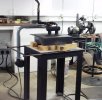- Joined
- Jan 9, 2011
- Messages
- 16,397
BFlying you get big points for ingenuity and froogleness lol. The duct tape and amazon box really take it over the top :thumbup:
Dan you may find this thread useful if you haven't seen it.
http://www.bladeforums.com/forums/s...Burner-Plans-and-info?p=14536251#post14536251
Its a write up Stacy did helping another member build a forge. Lots of good info and if I build one its something I plan to reference heavily.
That said I have so many shop tasks to complete I'm on the fence as to building or buying one also. I know Atlas makes a nice forge that is reasonably priced and he also posts here regularly.
I'm interested in the responses you'll get.
Thanks, that build looks great! I think I could pull that off without blowing anything up...
I initially bought most of the parts to build a forge but the time to shop all the parts and the how-to's were taking too long. I wanted to get started already. So I bought one. I build lots of things I need but the forge was one of the things that was quicker just to buy it. I got it from this guy:
http://majesticforge.com/knifemaker_forges_products.html
I really like those and the lining really looks good. Do you like the way the burners work? I found myself wanting to buy one of the larger ones.
I started with an Ellis 6", but wanted a larger and blown. The link Augus provided was Stacey helping me. As easy as it was to build, I wouldnt buy one if you have the ability to build one.
Thanks for the second on that! I'm going to look further.
If you build one, you can make it as you wish. For the same money, a build forge will be far better than a bought forge. A PID controlled forge has to be built, as I know of none available pre-made.
Good point on making it better for the same price, I want something really solid.
Thanks Stacy! Your posts literally walked me through making my first knife and I really appreciate your huge contribution here.
I had never seen or used a venturi forge when I purchased my first one and had never used a blown forge before I purchased mine. Having now seen and understand how they work I would not consider buying one in the future. I can make it cheap, fast and completely functional. That being said if you are in the same boat as I was, purchasing a decent forge is not a bad investment. If you already understand how they work and have checked out a few, just build one.
Thanks! I'm debating that right now as it takes time to learn how to make a forge... I'm still pretty clueless at the moment but this thread has helped me immensely.
Just make your own, it's super easy. Just follow Stacy's inductions and you'll have no problems! I've been slowly gathering parts to make a blown forge. I built a venturi burner and it works, but there's not much way to regulate how it heats things. It kinda just wants to be at one temp. Blown burners are way more versatile!
That is good to know especially about the versatility part. More to look up and that is a good thing, much thanks!


